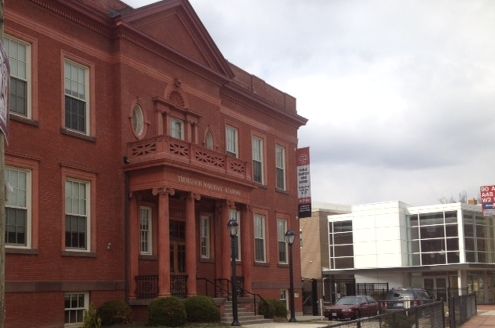http://prism2.si.edu/Pages/SI-WideArchive.aspx
I attended a symposium on temperate forests ecosystem at Smithsonian. Much of it was about earth history, deep earth history. When you want to look forward, it is a good idea to look back. Almost everything you can reasonably expect could happen in the future has happened in the past. Earth has been much warmer and much cooler in that past than it is today.
Climate change will bring ecosystems with associations of plant and animal that nobody has seen before, but it has happened before. We call them “novel” ecosystems. We can get an idea of the novel ecosystems of a potentially warmer future by looking at what was around during similar periods in earth history.
Emergence of flowering plants
Angiosperms, flowering plants, the plants and trees we are used to seeing around us today, developed in the early Cretaceous period around 160 million years ago. (BTW – the famous movie should probably have been called “Cretaceous Park” instead of “Jurassic Park,” since the lead dinosaurs were from that period, but that is another story.) Flowering plants developed in the tropics and then moved into temperate regions, first along riverbeds and in disturbed areas. Today we might call them invasive species. By the middle Cretaceous, they were globally distributed and often dominant and by 70 million years ago, many of our now familiar families of trees were well established. The details and relationships among species were different, but these ancient forests would look broadly familiar to us. This was one of the golden ages of temperate forests.
Then we had the mass die offs at the end of the Mesozoic, the same one that killed the dinosaurs. Around 50% of all plant species went extinct. The fossil record cannot tell us exactly how long it took, but it was quick in terms of geological time. Forests quickly recovered their diversity as the world got warmer, with tropical rain forests spreading up to 40 degrees North, about where Colorado would be and it got even warmer still with a boreal-tropical forest, where today we have cold northern forests. There were forests north of 80 degrees and paleontologists found fossilized stumps that indicate dense forests of trees resembling metasequoia (dawn redwoods now common in Virginia gardens) on Ellesmere Island, a place of permafrost & tundra today where nothing grows more than a few feet high.
Sudden greenhouse warming
A sudden greenhouse event brought rapid warming of 4-8 degrees C about 56 million years ago. This warm period lasted around 200,000 years, a long time to us, but not very much in the great scheme of geological time. Tropical vegetation moved far into what are now temperate or even cold regions. South America had vast eucalyptus forests.
Followed by a slow cooling
Eucalyptus in South America died out in during subsequent cooling phase. They are back in South America today, but the new ones are from Australia. A slow cooling began about 44 million years ago and we are still in that colder age. About 6 million years ago, we started to see periodic ice ages, as the Greenland ice sheet formed and glaciers advanced in the Himalayan highlands. What exactly caused the cooling is a subject of speculation. The leading theory is that it had to do with movements of landmasses that isolated the Arctic Ocean and allowed ice to form, the movement of the Antarctic continent to the middle of the polar region, where it could freeze more or less solid and the up thrust of the Tibetan Plateau, which cooled of the heart of Eurasia.
Data from the past is hard to get; data from the future is impossible. Natural history provides a rich mine of information about how forests will respond to rapid climate change.
The next speaker talked about associations of plants and animals. In times past, distributions of tree and plant species was sometimes different from what we see today. For example, today the ranges of ash trees and spruce trees do not much overlap. But in the Ice Age their distributions overlapped to greater extent. There is no natural association like that today. Difference in climate was not the only cause.
Strange relationships
Many “strange” mixes occur when there is a disequilibrium caused by big changes. The change in climate was one such cause, but not the only one. In this time in the past, large mammals (woolly mammoth, American camels, stag-moose, woolly rhinos, giant ground sloths and horses.) largely disappeared, probably because of humans showing up and hunting them to extinction, but there were a variety of factors at work. Although there is some dispute about the exact cause, (some scientists refuse to blame humans), there was clearly a disequilibrium created and it happened rapidly, in the course of less than 1000 years. Large herbivores play important ecological roles in that they eat and trample lots of vegetation. They are important in keeping open forests or grasslands free of trees and brush. When they disappear, forests close. And there is another knock off effect – fire. Fire is an herbivore. If animals do not eat the brush, it accumulates and eventually catches on fire. Humans would have increased the incidence of fire. There have always been fires, but the intensity varies. So what you see is greater variation, since the fires were more destructive when they came, but less constant than the grazing or browsing of the large herbivores.
The forests of 14,000 – 12,000 years ago were different from those of today for both climate and other land use reasons mentioned above. During the Ice Age there was greater seasonal variation than today with relatively hotter summers and significantly colder winters. For plants and animals in the environment, what matters is not the average, but the extremes. Something can be perfectly adapted 360 days of the year, but if the extreme weather of those last five days kills it, it will disappear. When you get extremes, then, it simplifies the environment, i.e. fewer species can find niches and so the forests are dominated by only a few species. You see that today in the difference between tropical forests, with thousands of species on every acre and boreal forests with only a few types of trees dominating vast swaths of land.
End of the last ice age, still changing
The Ice Age ended and the world warmed rapidly. Forests in North America again spread north to about where they are now. Our last speaker, Jonathon Thompson from Harvard Forest talked about more recent history.
The last 400 years has been a story of disturbance and recovery in the forests in Eastern North America. In Massachusetts, for example, deforestation peaked about 1850 and forests recovered rapidly until the 1970s, when urbanization started to equal or slightly exceed the rate of forest regrowth. The regenerated forests are similar to the old ones, but different in details such as age and precise composition. Newer forests, for example, are younger and earlier on the stage of succession. This is no big surprise. They just are not that old and more likely to be recently disturbed.
The composition is different
Researchers tried to get an idea of the former forest composition by looking at “witness tree” records. Witness trees were those used to mark property lines. They are described in some detail in old deeds. Usually, they would set down a marker and then describe the trees in all directions, in order to discourage someone moving it. Using these trees introduces some bias, since witness trees would more likely to be big and easy to spot, not a random distribution, but it gives some idea.
In the last centuries, there have been changes. Chestnuts are gone entirely. The chestnut blight explains this. Beech declined significantly, by around 15%. This is maybe explained by the age of the forest. Beech trees are late succession species, i.e. they are shade tolerant and start to come in when the forest is well established. Maples are more common now. The researchers went only to genus, and not to the species level, but they think there has been a big change among maples, with red maples displacing sugar maples to some extent. Oaks have declined, but not by that much and the same goes for hemlock, when not affected by the woolly adelgid. Hemlocks have been declining for 5000 years, however. They were once more common and evidently got some kind of stress thousands of years ago. The decline of the oaks may be an artifact of the study. Oaks are large and long-lived trees. They would be natural candidates as witness trees, so maybe they were just chosen more often.
Anyway, I learned some things I did not know and remembered other things that I had forgotten. Being able to attend such symposiums is one of the big advantages to working at Smithsonian.




